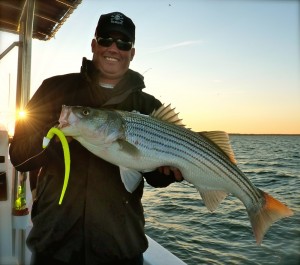 This week I’ve been fishing both north and south of Kent Island. I’m running along the deeper ledges looking for big birds either diving on breaking fish, flying high, or sitting. Since the fall turnover, the better fish have been feeding deep, sometimes thirty five feet deep or more. Once they round up a school of four to six inch bunker, they force them to the surface then explode into them knocking the hapless baitfish into the air where the gulls are waiting. The fish aren’t breaking in big pods but moving around in twenty to thirty fish rat packs. I usually only see a few splashes here and there to send down the birds. The predators move on quickly, so by the time you get to where you saw the splashes, they’re usually gone. The trick to catching them is to figure out what is attracting them to the location and try to anticipate their next move. While migratory stripers will feed wherever they find baitfish, this time of year they’re still running with Chesapeake residents so it’s more likely they are relating to underwater structure. That structure will probably be a live hard bottom near a steep subsurface ledge, especially ledges located near the mouths of tributary rivers. So when big fish are breaking here and there and not really schooled up, the best bet is to simply set up a drift near the ledge and wait for them to come to you.
This week I’ve been fishing both north and south of Kent Island. I’m running along the deeper ledges looking for big birds either diving on breaking fish, flying high, or sitting. Since the fall turnover, the better fish have been feeding deep, sometimes thirty five feet deep or more. Once they round up a school of four to six inch bunker, they force them to the surface then explode into them knocking the hapless baitfish into the air where the gulls are waiting. The fish aren’t breaking in big pods but moving around in twenty to thirty fish rat packs. I usually only see a few splashes here and there to send down the birds. The predators move on quickly, so by the time you get to where you saw the splashes, they’re usually gone. The trick to catching them is to figure out what is attracting them to the location and try to anticipate their next move. While migratory stripers will feed wherever they find baitfish, this time of year they’re still running with Chesapeake residents so it’s more likely they are relating to underwater structure. That structure will probably be a live hard bottom near a steep subsurface ledge, especially ledges located near the mouths of tributary rivers. So when big fish are breaking here and there and not really schooled up, the best bet is to simply set up a drift near the ledge and wait for them to come to you.
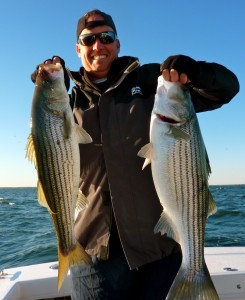
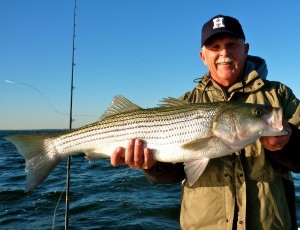 That’s exactly how I’ve been fishing this week. Whether above or below Kent Island, big birds have pointed out the ledges where the fish are feeding. My typical strategy is to find the birds and start jigging under them. After the birds fly off, I just continue the drift constantly scanning my fish finder for bait and fish echoes. If I stay relatively quiet and don’t restart the engine, the fish will actually follow me around even though I’m throwing artificial lures.
That’s exactly how I’ve been fishing this week. Whether above or below Kent Island, big birds have pointed out the ledges where the fish are feeding. My typical strategy is to find the birds and start jigging under them. After the birds fly off, I just continue the drift constantly scanning my fish finder for bait and fish echoes. If I stay relatively quiet and don’t restart the engine, the fish will actually follow me around even though I’m throwing artificial lures.
Here’s how it works: Once someone on the boat hooks up, the underwater commotion will attract more fish. Schooling stripers are a lot like frenzied gulls. When one get’s a hold of something to eat, the others chase it around frantically. If we can keep catching, the curious fish stay near the boat, especially if the wind is favorable so we can drift along the ledge. Stealth is essential. If another boat starts up or trolls nearby, the engine noise will send the fish packing. Some successful drifts this week have stretched out as far as a half mile with the fish staying right beneath the boat and clearly visible on the fish finder. I’ve kept fish under the boat for as long as two miles in the past.
The pictures in this report are from a short Monday evening trip when Rich and Brian joined me on Thunder Road. I didn’t have much time to fish but we were fortunate enough to find stripers feeding right where we wanted them to be. We started hooking up right away on six and ten inch hotrodded BKDs and stayed on the fish until well after sunset. Most of our fish were in the mid to high twenty inch range, but in the two hour window we had available we released six well-fed stripers over thirty inches long with Brian getting the biggest fish of the night at thirty three.
I also got out one evening with Candy, Joe, and Collen. Once again we popped right in and found fi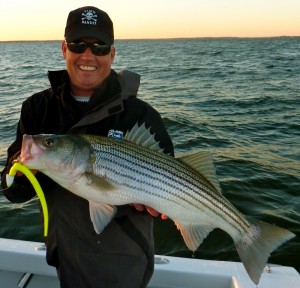 sh quickly, opening the night with some really nice stripers. The biggest checked in at thirty eight inches (or thirty seven depending on who was doing the measuring). It was a pretty evening with calm sees and bluebird skies so there were a lot of boats around. All the trolling, running, and gunning kept the fish scattered and on the move, so we left the crowd and found more productive waters a few miles to the north. We finished the night with a bang, catching more fish by throwing top-water lures and six inch BKDs over another hard-bottom ledge. I left the picture-taking to the experts and I think Candy may file a report later this weekend.
sh quickly, opening the night with some really nice stripers. The biggest checked in at thirty eight inches (or thirty seven depending on who was doing the measuring). It was a pretty evening with calm sees and bluebird skies so there were a lot of boats around. All the trolling, running, and gunning kept the fish scattered and on the move, so we left the crowd and found more productive waters a few miles to the north. We finished the night with a bang, catching more fish by throwing top-water lures and six inch BKDs over another hard-bottom ledge. I left the picture-taking to the experts and I think Candy may file a report later this weekend.
I hope to fish again Saturday or Sunday. I’ll be looking at the same pattern. Since more and more migratory fish are entering the Bay, we should start seeing a few forty inchers in the mix soon. Water temperatures are hovering around 60 degrees and should fall fast since there is another cold front on the horizon. I won’t be surprised if we start spotting a few gannets in the next few days. We’re experiencing the best fishing of the Fall right now, so make sure you’ve got some big lures on the boat and get out there and get ’em!




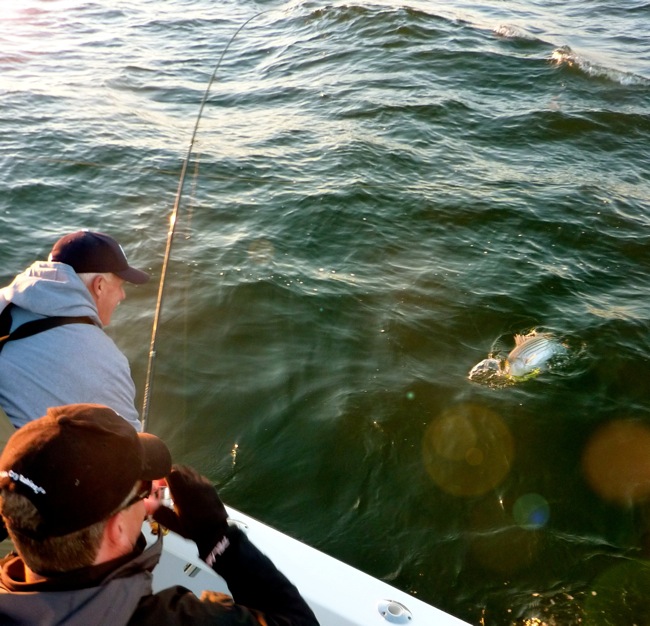
Another informative report Shawn. I didn’t know fish can stay under the boat but I guess it makes sense with all the excitment going on. I’m going out tomorrow to look for those big birds and steep ledges.
Let’s hope it lasts through mid-November!
I always suspected fish follow a boat when you’re catching but never read about it until now. There’s so much to process about casting lures. Thanks for bringing things into the 21st century for those of us who don’t get out much.
This is the best website I have found in regards to fishing for stripers in the Chesapeake. I don’t make it down to the Bay Bridge area much do to my boat being undersized but the same techniques work great in the Upper reaches of the Bay too. Very informative site and keep the great work!
Fish following a boat around. Now I’ve heard everything!
Shawn..great read, I don’t think people realize how much difference “stealth” mode makes when fishing…motor off etc..actually the proof is in the pics..sometimes it’s really hard sitting still when you see splashes in the distance, and patience is not one of my assets..but big fish didn’t get big by not being cautious…very informative..
Wish they would follow my boat’)seriously, Ive seen them follow a hooked fish to the boat before so it makes perfect sense.
Thanks for another info packed read,Shawn.
Shawn thank you for sharing your knowledge with us I have caught more fish this year after finding your web page then ever
I want to take a moment to thank you for sharing your reports and LT techniques on your website. I recently found this website a couple weeks ago and I thoroughly enjoy reading your reports & articles. I’ve had many years fishing the bay, mostly trolling and live line. However from your articles, techniques & reports, I now have another approach and appreciation when it comes to fishing the bay. I know many fishermen and have gone out with different charter captains on the bay and in the ocean. However, I’ve not met anyone so willing to share their knowledge in a more articulate fashion as you. I would like to go out on the bay with you all sometime if you ever need an extra in your crew or take you out with us when you’re available.
I noticed you had Candice with you this past week. I met her at the Bill Burton Youth Fishing Derby when she was interviewing my son. Say hello for us if you see her again. Thanks for sharing.
THanks for all the nice comments. Stay tuned because I’ve got some hot information coming out in the next couple of days. I also heard from Candy who said the video she shot this week turned out great. I’ll let you know when it goes live. Also, thanks for spreading the word about CLT. They guys hosting the site tell me web hits have been off the hook the past couple of weeks. Keep in touch and good luck out there!
Another terrific entry into the best site focused on the Bay Shawn. You are making us much better anglers, thanks!
Thanks Shawn for all the great info. Cant wait to read your next article. They are always well written,informative, and most of all entertaining. Haven’t caught one yet LTJ but looking forward to it as soon as the wind calms. s/sw winds have been making life difficult leaving the eastern shore.
Shawn,
One point you may have already made and I missed: when one person hooks up, have him slow the rate at which he brings the fish into the boat. As you stated, there are likely a number of fish following the hooked up fish. A second rod can cast beyond the hooked up fish and will likely get a hook up. This process can be repeated for a considerable number of fish before the school moves on. We have caught as many as 10 BIG fish in quick sequence before the school moved on; simply by delaying the boating of the first fish until a second rod was into another fish.